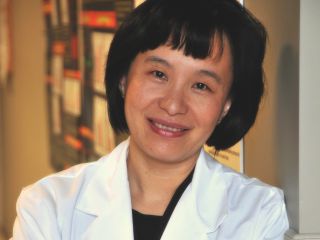Over the coming months, look for videos, stories and events that feature some of the many Wayne State initiatives and passionate individuals committed to impacting their communities through innovation and entrepreneurship. This content is part of WSU's Warriors in Action campaign highlighting how Wayne State is making a difference.
 Research findings made in the laboratory of Guangzhao Mao may result in a significant shift to manufacturing on the nanoscale. Mao, a chemical engineering and materials science professor in the Wayne State College of Engineering, and her team have been working over the last year on a proof-of-concept project that introduces a new fabrication approach to nanosensor devices. They are developing a one-step technique that allows for controllable growth of nanocrystals directly on microfabricated substrates.
Research findings made in the laboratory of Guangzhao Mao may result in a significant shift to manufacturing on the nanoscale. Mao, a chemical engineering and materials science professor in the Wayne State College of Engineering, and her team have been working over the last year on a proof-of-concept project that introduces a new fabrication approach to nanosensor devices. They are developing a one-step technique that allows for controllable growth of nanocrystals directly on microfabricated substrates.
This low-cost, room-temperature process is based on Mao’s basic research in the last decade, currently funded by a $330,000 National Science Foundation grant, which explores an innovative, solution-based process using nanoparticles as seeds. This technique was adapted from a seed-mediated crystallization process used in the manufacturing of medical drugs.
The original premise was that small seeds can make small crystals that can form nanowires. The next step is to commercialize this methodology.
“Nanowires have been applied to sensing for over 10 years, but few nanowire sensors have reached the market,” said Mao. “The major barriers are the complexity of manufacturing and difficulty in manipulating and connecting nanowires in microelectronic devices.”
Mao recognized that there is a lack of manufacturing methods to connect different nanomaterials into one device. Nanomaterials are currently being put into sensors mostly through photolithography, which is very expensive and limited by the need for cleanroom environments and nanoscale precision.
“Our technology can potentially overcome these barriers by using a different fabrication approach and with materials not previously used in nanowires,” said Mao.
The new process is based on the patented, solution-based approach that consists of mixing organic crystalline compounds with nanoparticles, which nucleate upon solvent evaporation.
Among the benefits of this new system are reduced capital investments, a simpler fabrication process and the creation of a broader range of nanowires.
To further prove this concept’s suitability, Mao’s research team is constructing and testing an organic electrochemical nanosensor for gas and vapor sensing. With this tool, they will be able to measure the electrical conductivity change of nanowires when exposed to gases, as well as demonstrate functionality and scalability of this process.
Nicholas Cucinelli, an experienced technology entrepreneur in the Detroit area, has played an important role in his position as an advisor and mentor in the Tech Transfer Talent Network (T3N), a program funded by the Michigan Economic Development Corporation that aids in launching technology-based startups and reaching commercial licensing agreements for university inventions. Wayne State is among seven T3N universities in the state of Michigan.
Cucinelli first met Mao through the Technology Development Incubator program, where he served as a proposal reviewer. After assessing her work, he collaborated with Mao to obtain additional funding through the Partnerships for Innovation: Accelerating Innovation Research-Technology Transfer program, an NSF initiative that helps bridge the gap between scientific discoveries and market-valued solutions.
Today, Cucinelli is a co-principal investigator on this project, primarily charged with helping the research team zero in on the best applications for this technology for commercialization.
Cucinelli noted that under the Bayh-Dole Act, a piece of legislation dating back to the late 1970s, universities own intellectual property created with federal funding. As long as the universities act as good stewards to that technology, they can pursue ways to monetize it.
“So aside from the societal benefit of generating new knowledge and solving human and environmental problems, this is about creating some kind of deeper, long-term return on investment for those taxpayer-funded basic and applied research projects,” said Cucinelli. “This is a pathway to getting additional dollars back into the economy and the university’s ecosystem through the commercialization process.”
Also joining Mao in this pursuit is Fulbright Scholar Mohamed Kilani, who came to Wayne State from Tunisia. According to Mao, working on this project has enabled Kilani “to develop tech transfer and business knowledge and skills, which is well beyond the traditional graduate training.”
Kilani, who is pursuing a master’s in materials science, is following up on years of research performed by graduate students who came before him and is excited to be part of the applied research phase. One useful pathway for the technology is measuring air quality, which could impact many industries concerned with environmental or health safety issues.
“We conducted many tests for selectivity. We tried many types of gases — water vapor, ammonia, many types of alcohols,” said Kilani. “We also tested the sensitivity to determine the lowest concentration that can be detected by our sensor. We found that you can detect less than two parts per million, and I think we can get lower than that.”
“It’s extremely valuable to have a platform technology like this that has multiple applications, but you can’t work on all of them at the same time,” adds Cucinelli. “You have to latch on to something and show real market value before you can commercialize the entire platform and the full potential of the technology.”